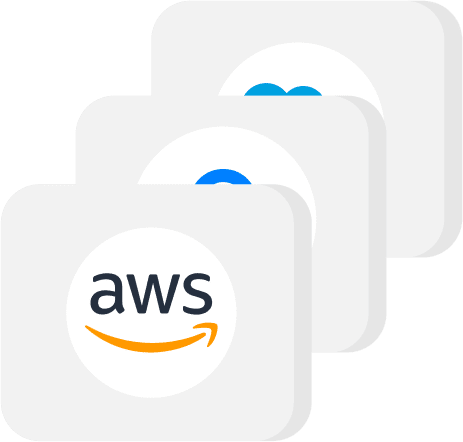Amazon Lambda
A quick overview of Amazon Lambda
Amazon Lambda allows for running application or backend code without administration costs. More specifically, this reduces the need for managing servers, workload scaling logic, maintaining event scaling, and more.
Why Amazon Lambda?
AWS Lambda is a service Amazon Web Services offers that facilitates serverless computing. It operates by executing code in reaction to specific triggers, such as data modifications or user interactions. The key advantage of AWS Lambda is that it completely abstracts server management away from the user, allowing developers to dedicate more time to code creation rather than infrastructure concerns. This service dynamically allocates computational resources based on incoming requests or events, ensuring efficient processing and scalability. It can react to events such as:
- DynamoDB changes: Trigger Lambda functions with every insert, update, or delete operation.
- SNS messages: Activate Lambda functions to process messages published to an SNS topic.
- S3 objects: Execute code in response to creating, modifying, or deleting objects in an S3 bucket.
- Kinesis streams: Process real-time data streams by invoking Lambda functions.
Lambda is also optimized to work with other AWS services with just a few calls from an application. Lambda can work with various programming languages, including Node.js, Java, and Python. Lambda files can be developed on serverless and container applications such as AWS SAM for testing functionality and building.
No servers to manage
AWS Lambda does not require any base physical infrastructure to run on to carry out your tasks. Utilizing is simply a matter of uploading your code for it to automatically run.
Continuous scaling
Resources for calculations are automatically added and retracted in response to each event. The uploaded code continues to run in parallel and scales directly to the size of the current task. Task sizes can range from a few per day to hundreds of thousands in mere seconds.
Proper cost-optimization
You will never have to overpay for what resources you use. Running your code will charge you by the millisecond and the number of times your code is ran. In totality, you can save upwards of an additional 17%.
Consistent performance
Adjusting memory size to fit your program is incredibly easy. Running the program back-to-back can also be done within the double didgit milliseconds by enabling Provisioned Concurrency.
Amazon Lambda Features
Lambda is used to either integrate other AWS services with custom logic or work on your personal back-end services with AWS scale, security, and performance. For a more in-depth overview of what AWS Lambda has to offer, everything can be found in totality here.
Modify AWS with custom logic
Integrating new code changes how certain AWS services will process new data. After uploading the code and establishing individual settings, the code will be tied to a service of your specification. The service will then act as a trigger condition, subsequently running the code and enacting changes to the new data.
- Mobile Apps: Lambda can handle backend processes, such as authentication and data processing, seamlessly.
- Internet of Things (IoT) Backends: It processes data from various IoT devices, ensuring real-time data analytics and responses.
- Big Data Systems: Lambda is capable of processing large amounts of data efficiently, making it a preferred choice for big data analytics.
No new tools
Lambda lets you use coding languages of your choice. Third-party and native libraries work.
Highly automated
The need to worry about OS updates or resizing as usage continues is removed. Maintenance, security, self-deployment, administration, activity logging, and monitoring all come with the package.
Fault-tolerant
In the same way all other AWS services are preserved, Lambda maintains capacity across availability zones, meaning it can still run should an availability zone facility suffer a system error.
Links with AWS RDS
Using Amazon RDS Proxy, Lambda can be set up using the in-house database services, making it incredibly easy to set up several serverless applications that require database interactions.
Manual control of performance
Provisioned Concurrency can either be used to keep applications at the ready for a surge of intake, or lowered or turned off completely during inactivity.
Connects to shared files
Amazon Elastic File System (EFS) lets users read, write, and persist high volumes at low frequencies at any scale. This forgoes the need to download data for temporary storage, simplifying the application’s complexity.
Tight budget control
Pay only for what you use. Since Lambda charges by the millisecond, there won’t be a single second you will be overpaying for. Add to that the ability to control what resources you are using and it is very easy to budget your Lambda use.
AWS Lambda Pricing
Lambda uses a pay-as-you-go model where users are charged based on what resources they use, how many requests they make, and the code’s run time. Run time is calculated by when the code is called to when it either returns or terminates, rounded up to the nearest millisecond. This means that users are only billed for the actual time their code is executing and not for the time when it is idle or not running. In addition to the pay-as-you-go model, several factors contribute to the pricing of AWS Lambda services. These factors include the amount of memory allocated to the program and the CPU power applied. By allocating more memory to a Lambda function, users can expect higher performance and faster execution times, but it also affects the overall cost. Similarly, the CPU power utilized by the function also affects the billing, as higher CPU power may result in faster execution but at a higher cost.
It is worth noting that Lambda functions are triggered automatically and scale to meet the compute demand required by the workload. This means that Lambda can handle a few requests daily or scale up to thousands of requests per second, providing flexibility and scalability to users without the need to manage the infrastructure. While the specific pricing details of Lambda are dependent on factors such as memory allocation and CPU power, users can find further information on function configuration on the AWS documentation. These details will help users understand the cost implications of different configurations and make informed decisions to optimize their usage and manage costs effectively.
Decreasing the quantity of requests made to your Lambda functions is indeed a viable method to lower the associated costs. In addition to minimizing requests, you can also achieve cost reduction by enhancing code for better performance, minimizing logging activities, and taking advantage of cost-effective options like provisioned concurrency and AWS Savings Plans.
To efficiently manage and optimize Lambda costs, there are several important steps you can take to understand and control your expenses:
1. Familiarize yourself with the AWS Lambda pricing model: It is crucial to have a clear understanding of how AWS Lambda billing works. Familiarize yourself with concepts such as request count, duration, and memory allocation to make better decisions when optimizing costs.
2. Monitor and analyze Lambda usage: Regularly monitor your Lambda function’s usage patterns and overall resource consumption. Utilize tools like AWS CloudWatch to gather detailed metrics and logs, providing insights into function execution and associated costs.
3. Analyze costs at different granularities: Break down Lambda costs by different dimensions such as function, environment, and service, to gain a comprehensive understanding of where expenses are being incurred. This analysis helps in identifying areas that could be optimized.
4. Right-size your Lambda functions: To avoid over-provisioning or underutilization, it is important to select the appropriate amount of memory allocation for your functions. Continuously evaluate and adjust this based on actual usage patterns to optimize costs.
5. Optimize execution time: Since Lambda costs are based on execution duration, optimizing the code and reducing execution time can significantly impact costs. Analyze your code to identify performance bottlenecks and optimize accordingly.
6. Implement automated scaling: By implementing auto-scaling, you ensure that your Lambda functions are dynamically adjusting to the workload demands. This allows for efficient resource utilization and cost optimization during periods of low activity.
7. Use reserved concurrency and provisioned concurrency: Reserved concurrency allows you to pre-allocate a specific number of requests, ensuring availability without unexpected cost spikes. Provisioned concurrency keeps a certain number of instances warm and ready to execute functions, reducing cold start delays and optimizing costs.
8. Utilize cost allocation tags: AWS provides the ability to assign cost allocation tags to resources, allowing you to categorize Lambda costs by specific criteria, such as project, team, or client. This enables you to better track and manage costs for different business units or projects.
9. Leverage architectural and design best practices: Consider optimizing your overall serverless architecture and design choices to minimize unnecessary function invocations and data transfer between services. This can lead to reduced costs and improved performance.
10. Regularly review and optimize: Continuously monitor and analyze your Lambda costs, making adjustments and optimizations as necessary. This iterative approach ensures ongoing cost optimization and prevents unexpected billing surprises.
Further details on function configuration can be found here.
Free Tier
AWS Lambda does offer a free trial for new and unsure users. This tier offers one million free requests and 400,000 GB-seconds of compute time per month.
Price Calculations
AWS Lambda costs are composed of multiple factors that influence the final bill. Compute charges are one of the primary costs, calculated based on the duration of your Lambda functions’ execution time and the amount of memory allocated. These charges are meticulously billed in increments of 100 milliseconds, ensuring you pay only for the precise time your functions are active. Additionally, each invocation of your Lambda function incurs a request charge. AWS implements a pricing model that charges per 1 million requests, highlighting the need to design efficient applications that minimize unnecessary function triggers. Furthermore, data transfer costs should also be considered. These charges occur when Lambda functions interact with other AWS services or external resources, and include data transfers both into and out of Lambda functions as well as between different regions and availability zones.
The spreadsheets of prices and formulas for billing users can be found here in full detail. There are additional deviations in rates based on the regions that users are operating in. If you want to experiment with what your bill would look like with your desired resources, you can use the AWS Pricing Calculator found here. For general economics on AWS’ resources, more resources can be found here.
Risks of not monitoring Lambda costs properly
Monitoring AWS Lambda costs is crucial to avoid potential risks and financial challenges. Failing to do so can lead to various negative outcomes. Without effective monitoring, managing your AWS bill can become overwhelming and difficult. It is common for manual calculators to lose control, resulting in unexpected costs and budget overruns. This lack of control can be compared to a runaway truck, as the costs can quickly spiral out of hand. While Lambda is often chosen for its potential cost savings and operational ease, using it indiscriminately may not always result in desirable cost reductions. Without proper optimization of AWS costs, organizations may not fully benefit from the potential savings or achieve a higher return on investment (ROI). Organizations may not be aware of cost anomalies without proper monitoring until it’s too late. Detecting and addressing these anomalies promptly is crucial to avoid unnecessary financial losses. Similar to Adobe’s unfortunate experience, delayed realization can result in substantial financial damage.
To fully leverage the AWS Lambda Free Tier and ensure optimal cost-efficiency, consider the following strategies:
Optimize Function Code: Write efficient code to reduce execution time. The quicker your function executes, the more you can do within the free tier limits. Efficient code not only saves execution time but also minimizes the cost by staying within the free allocations.
Monitor Usage with Tools: Regularly monitor your AWS Lambda usage with tools like CloudWatch to ensure you stay within the free tier limits. This monitoring will help you understand your usage patterns and adjust them before they can result in cost overruns.
Utilize API Gateway: If HTTP requests trigger your Lambda function, integrate it with Amazon API Gateway. Both services offer a free tier, and using them together can maximize your usage without additional costs while efficiently managing and monitoring these requests.
Experiment and Learn: The free tier is an excellent opportunity to experiment with different use cases, programming languages, and integrations. Use this environment to innovate and develop without worrying about immediate costs, allowing for a broader testing and learning spectrum.
Getting Started With Amazon Lambda
AWS has ample documentation and tutorials for you to start learning how to fully utilize your Lambda function. But before anything, it is advised that you look through this page for use cases and understand how Lambda can benefit your project and applications. Over the course of these tutorials, you will also learn to use serverless development tools like AWS Cloud9. For everything from initially uploading a Lambda function to editing and testing, to managing the functions, working with specific coding languages, and troubleshooting, all the documentation is laid in full here.
1. Log in
Log in or sign up to the AWS Management Console and set up your root account. You will also want to install the AWS Command Line Interface (CLI) if you plan on configuring Lambda Functions from the command line.
2. Create a function
Functions can be uploaded as either a ZIP file or a container image. Here are a couple of tutorials for both methods.
3. Editing the code
Lambda does provide an environment in which you can modify your uploaded function. It functions like any other editor and can be adjusted to your personal preference. For more on the Lambda editor console, everything is right here.
4. AWS CLI
The Command Line Interface is for managing functions and the resources at your Lambda function’s disposal. This is for creating execution roles, creating functions, and listing Lambda functions on your account. Tutorials can be found here.
5. Quotas
There are hard limits on the total resources that can be expended for all operations by a Lambda function. While a few resources like the number of concurrent functions being run in parallel and the storage for your functions can be renegotiated, most of these limits cannot be raised.
When considering the cost-effectiveness of running applications on AWS Lambda, it is crucial to be mindful of these quotas and resource limits. Understanding the boundaries within which your Lambda functions operate is essential for managing costs efficiently. While some limits, such as the number of concurrent functions and storage, can be adjusted, it is important to note that many of these constraints are fixed and cannot be raised. All the numbers and caps are listed here.
In addition to these hard limits, it is also important to explore strategies for optimizing AWS Lambda costs to ensure that you are getting the best value for your money. From right-sizing your functions to minimizing logging output and leveraging compute savings plans, there are various tactics that can help you control expenses while maintaining the performance and scalability your applications require. By being cognizant of both the resource constraints and cost optimization strategies, you can effectively manage your AWS Lambda costs and ensure the efficient operation of your serverless applications.
Need help with AWS Lambda?
Amazon Lambda Support
Need some extra help initiallizing your AWS Lambda functions? AllCode is an AWS Select Consulting Partner with 10+ years of experience developing cloud-based solutions for enterprise-scale applications.
Amazon trusts and recommends our services to businesses who need a hand or who are looking to cloudsource their technology stack. We are the experts to guide you down the path for successful use of cloud services.
Why AllCode

Expertise
Our software engineers have at least 10 years of experience working on complex, innovative projects for both startups and Fortune 500 companies.

Multi-vendor relationships
The trust we have built with our vendors makes us a preferred option for any business scale. We enable dynamic support for superior service offerings across various cloud providers.

Flexible
AllCode provides Nearshore, Offshore, and Hybrid delivery models to fit your objectives with precise skills and ample resources right when and where you need them.
